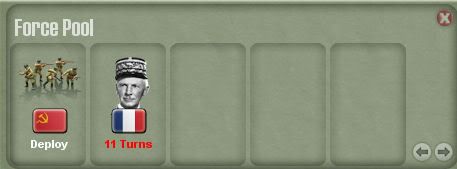fiskog wrote:1. Limit a country's embarked ground units to that country's number of surface naval units. Or maybe 1.5X with fractions round up. Or Maybe 1.5 for US, UK, and Germany, and 0.5 for Italy and Russia. In this way building a fleet would build AMPH capacity. There was no way that Germany or Russia could have had a dozen corps afloat at one time.
2. Put some effectiveness penalty on Axis units that enter the Russian winter on turns after the winter starts.
I think there is a problem with this. Later in the war you will see 10+ surface naval units for each of USA and Britain. It means they can have 15 transports embarked at the same time. If they arrive at the same time you can see 30 units landing in France on the same turn. That is not historical at all.
We have to distinguish between naval transports (moving between friendly ports) and amphibious landing crafts. I think it's important to keep the number of amphibious landing crafts available to each side rather low. The regeneration rate for those amphibious landing crafts should be low as well. The Allies had big fears about their Overlord landing knowing that if it failed then they would have to wait several months before they could try again.
If we're making a house rule then it's important to make a very simple rule so people won't forget about it all the time. Some wrote that it's cheesy that you can embark lots of corps units and sail them to the shore line and then decide to use the amph quota and land where you're not opposed. I don't think that's bad at all considering the non-historical fact that you can't invade an occupied hex in CeaW. If you can't use this strategy then it would be very easy for the defender to side slip his coastal defense units and block the units designated to be ampbhious landing crafts.
We have to keep focus on what we want to achieve here. The goal is to limit the number of units you can get ashore in one turn by invading enemy controlled hexes. Such landings required amphibious landing crafts and the lack of such crafts was the main reason the Allies spent so much time getting into action.
So we decided to make a simple rule saying that the max amph units you have is dependent upon the game year. 1939 = 2 units, 1940-1941 = 3 units, 1942-1943 = 4 units, 1944 = 5 units, 1945 = 6 units
Since we might be able to program the number of available amphs into the CeaW game code then it's possible to maybe make the max number of amphs a function of technology.
One possible formula could be:
Max number of amphs = tech level in surface ships + 1
Britain, Germany and USA start the game with surface ships tech level 1 and would therefore have the max amph capability of 2.
France, Russia and italy start the game with surface ships tech level 0 and would therefore have the max amph capabilit of 1.
This means that Germany should build naval labs and get better surface ships tech in order to increase the max number of amphs. Britain and USA will definitely build a few naval labs and would have tech 3 or so surface ships in 1943. That means max 4 amphs. This would also be a reason for Russia to build at least 1 lab so they can increase their max amphs from 1 to a higher value.
Would it be a good idea to make the max number of amphs a function of tech level in surface ships?
I think the house rule that you would get 1 amph back each turn until you reach the max level is a good one. It means you will spend some time to get full invasion capability if you use all your amphs.
But until such a change can be programmed then I think the max number of amphs being a function of game year is a good solution. It's not easy for the opponent to know your max capability so he can't verify if you not invade too many hexes.












